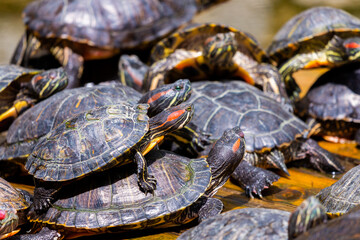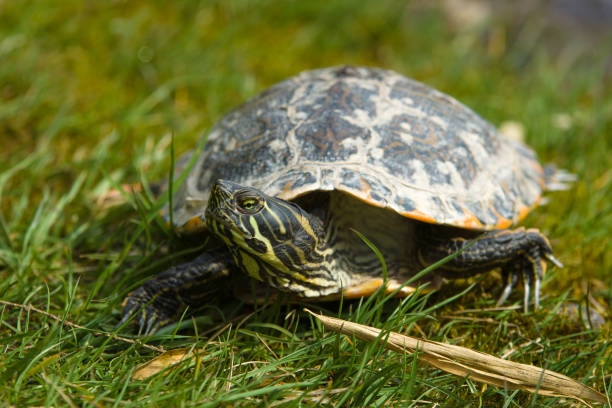Table of Contents
Scientific Classification
| Kingdom: | Animalia |
| Phylum | Chordata |
| Class | Reptilia |
| Order | Testudines |
| Family | Emydidae |
| Genus | Trachemys |
| Species | Trachemys scripta scripta |
| Scientific Name | Trachemys scripta scripta |
Description
The yellow-bellied slider is a semi-aquatic turtle known for its distinctive yellow markings and resilient nature. It features a smooth, oval shell (carapace) that ranges from olive green to brown, adorned with yellow stripes. The underside, or plastron, is a bright yellow with black spots. Males are generally smaller than females, reaching lengths of up to 9 inches, while females can grow as large as 13 inches. These turtles possess webbed feet that aid in swimming, and males have long claws that they use during courtship displays.
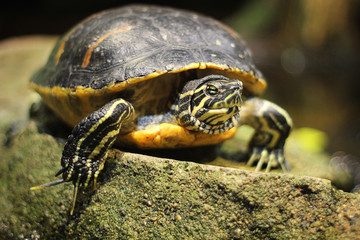
Distribution
Yellow-bellied sliders are native to the southeastern United States, primarily found in states like Florida, Georgia, South Carolina, and Alabama. Their adaptability has allowed them to spread to North America, Europe, and Asia through the pet trade.
Habitat
These turtles flourish in freshwater environments like ponds, lakes, slow-moving rivers, swamps, and marshes. They prefer areas rich in vegetation, where they can bask in the sun on logs, rocks, or riverbanks. Although they spend most of their time in the water, they need dry land for basking and nesting.
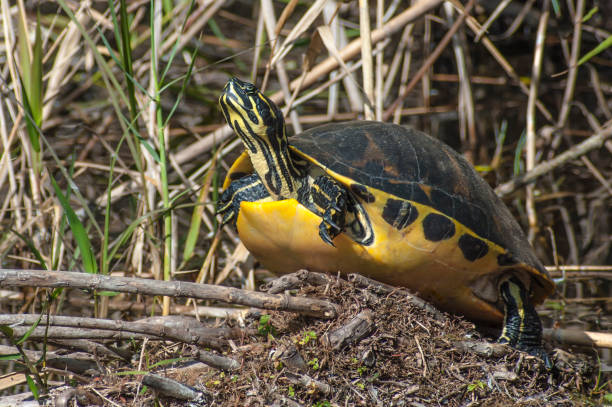
Diet
Yellow-bellied sliders are omnivores, which means they eat both plant and animal materials. Their diet includes:
- Aquatic plants
- Algae
- Insects
- Small fish
- Crustaceans
- Amphibians
In captivity, they may also consume juvenile fruits and vegetables, but as they mature, adults typically transition to a more herbivorous diet.
Behavior
These turtles are active during the day, which is what makes them diurnal. They often bask in the sun to help control their body temperature. If they feel threatened, they quickly plunge into the water to escape. They are social animals and are frequently observed basking in groups. Although they might be shy in their natural habitat, sliders kept in captivity can learn to interact with humans.
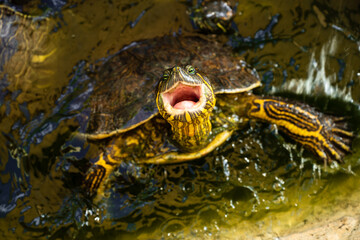
Lifespan
Yellow-bellied sliders are known for their impressive lifespan. In the wild, they usually live between 20 to 30 years. However, with the right care in captivity, they can exceed 40 years. Their longevity is influenced by factors such as their environment, diet, and protection from predators.
Reproduction and Lifecycle
The breeding season takes place in spring and early summer. During courtship, males use their long claws to softly stroke the female’s face. After mating, the female lays between 6 and 15 eggs in a nest she digs on land, typically close to water. The eggs incubate for about 2 to 3 months, with hatchlings appearing in late summer or early fall. The temperature plays a role in determining the sex of the hatchlings, with warmer conditions generally resulting in more females.

Predators
Adult yellow-bellied sliders have few natural predators because of their hard shells. However, hatchlings and juveniles are vulnerable. Common predators include:
Birds of prey (e.g., herons, hawks)
Raccoons
Snakes
Large fish
Alligators face many threats. In some places, things like habitat destruction and road accidents are major issues.
Adaptations
Yellow-bellied sliders have evolved several adaptations to survive in their environments:
Hard shell: Provides protection against predators.
Basking behavior: Helps regulate body temperature and maintain health.
Webbed feet: Enhance swimming efficiency.
Ability to hibernate: In colder areas, they can brumate. This means they bury themselves in mud to survive the winter.
Conservation Status
The yellow-bellied slider is not considered endangered, but certain populations are facing risks. They encounter challenges such as habitat loss, pollution, and the pet trade. Many of these turtles are released into areas where they don’t belong, leading to ecological disruptions. Conservation initiatives focus on safeguarding wetland habitats and regulating the pet trade to prevent issues with invasive species.
The yellow-bellied slider is an intriguing turtle. It is resilient and adapts well to both natural and captive environments. Its long lifespan and versatility make it a common yet remarkable reptile. This species plays an important role in its ecosystem by helping to control aquatic plant populations and serving as prey for larger animals. Protecting them is essential for maintaining the delicate balance of freshwater ecosystems around the globe.
